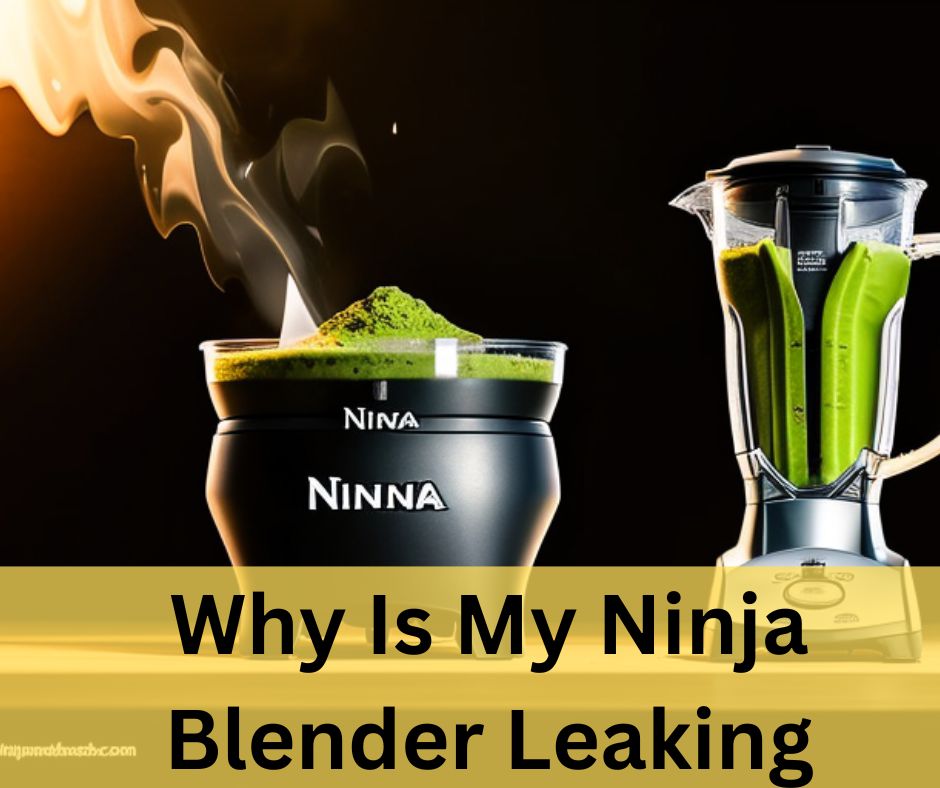Are you facing the frustrating issue of a leaking Ninja blender? We understand how this unexpected problem can disrupt your kitchen routine. But fret not! In this article, we’ve got you covered with all the essential information you need to address the question, “Why is my Ninja blender leaking?” Our goal is to provide you with a comprehensive understanding of the possible causes behind this issue and, most importantly, the solutions to prevent or fix it. So, if you’re seeking answers and solutions for your leaking Ninja blender, stay connected with us, as we unravel the details you need to keep your kitchen running smoothly.
Why Is My Ninja Blender Leaking

If you’ve ever found yourself wondering why your Ninja blender is leaking, you’re not alone. It’s a common issue that can be frustrating, but understanding the reasons behind it is the first step to finding a solution. Here are the main causes of a leaking Ninja blender, explained in detail:
-
Damaged or Worn Seals:
- Cause: One of the most common reasons for leakage is damaged or worn seals. The seals in your Ninja blender are designed to create a tight seal between the blade assembly and the container. Over time, these seals can wear out, crack, or become misaligned, leading to leaks.
- Solution: Check the seals for any visible damage or wear. If you notice issues, replace them with genuine Ninja replacement parts to ensure a proper seal.
-
Overfilling the Blender:
- Cause: Overfilling your blender beyond its recommended capacity can lead to leaks. When the ingredients exceed the blender’s limit, they can push against the lid or cause excessive pressure inside the container, forcing the liquid to escape.
- Solution: Follow the manufacturer’s guidelines for maximum fill levels and avoid overfilling the blender. It’s essential to leave some space for the ingredients to move freely without causing leaks.
-
Loose or Improperly Assembled Components:
- Cause: Loose or improperly assembled components, such as the blade assembly or the jar, can result in leaks. If these parts are not securely in place, there may be gaps that allow liquid to seep out during blending.
- Solution: Before each use, ensure that all components are correctly and tightly assembled. Check that the blade assembly is properly screwed onto the base and that the jar is securely attached.
-
Cracked or Damaged Blender Jar:
- Cause: A cracked or damaged blender jar can lead to leakage. Even a small crack in the jar can allow liquid to escape during blending.
- Solution: Inspect the blender jar for any cracks or damage. If you find any, it’s crucial to replace the jar to prevent further leakage and ensure safety.
-
Blender Overheating:
- Cause: Running the blender for an extended period can lead to overheating, causing the contents to expand and force their way out through the lid or seals.
- Solution: Avoid prolonged blending sessions. If you need to blend for an extended time, consider pausing and allowing the blender to cool down briefly before resuming.
How to Stop Your Ninja Blender Leaking
Experiencing a leaking Ninja blender can be frustrating, but there are several steps you can take to stop the leakage and ensure your blender works smoothly. Here’s a guide on how to stop your Ninja blender from leaking:
-
Inspect Seals and Gaskets:
- Cause: Leaks often occur due to damaged or worn seals and gaskets.
- Solution: Carefully examine the seals and gaskets in your blender. If you notice any cracks or signs of wear, it’s crucial to replace them with genuine Ninja replacement parts. Properly fitted seals and gaskets are essential for preventing leaks.
-
Proper Assembly:
- Cause: Loose or improperly assembled components can lead to leakage.
- Solution: Before each use, ensure that all blender components, including the blade assembly and jar, are correctly and securely assembled. Tighten the blade assembly onto the base, and ensure the jar is firmly attached.
-
Don’t Overfill:
- Cause: Overfilling the blender beyond its recommended capacity can cause leaks.
- Solution: Follow the manufacturer’s guidelines for maximum fill levels. Leaving some space in the jar allows ingredients to move freely during blending without causing leaks.
-
Avoid Overblending:
- Cause: Prolonged blending can create excessive heat and pressure, leading to leaks.
- Solution: Avoid blending for extended periods. If you need to blend for a more extended time, consider pausing to allow the blender to cool down briefly before resuming.
-
Regular Cleaning:
- Cause: Residue and food particles can accumulate and compromise the blender’s sealing capabilities.
- Solution: Clean and maintain your blender regularly. Follow the manufacturer’s cleaning instructions to ensure all parts, especially seals and gaskets, are free from residue buildup.
-
Replace a Damaged Jar:
- Cause: A cracked or damaged blender jar can be a source of leaks.
- Solution: If you find any cracks or damage on the blender jar, replace it with a new one to eliminate the leakage issue.
-
Blend in Stages:
- Cause: Overloading the blender with a large quantity of ingredients at once can lead to leaks.
- Solution: Consider blending ingredients in stages, especially when dealing with a substantial amount. This prevents overloading and reduces the risk of leaks.
-
Use Genuine Replacement Parts:
- Cause: Using non-genuine replacement parts can lead to improper sealing and leaks.
- Solution: When replacing any blender components, such as seals, gaskets, or jars, always opt for genuine Ninja replacement parts to ensure compatibility and a proper seal.
Why is my Ninja Blender Leaking Black Liquid?
If you find your Ninja blender leaking black liquid, it can be a puzzling and concerning issue. Fortunately, there are some common reasons for this problem, and understanding them can help you troubleshoot and resolve the issue effectively:
- Damaged or Worn Seals: The seals in your Ninja blender play a crucial role in preventing leaks. Over time, these seals can become damaged, cracked, or worn out, allowing liquid to escape. The black liquid may appear due to the accumulated residue in the damaged seals.
Solution: Inspect the seals for any visible damage or wear. If you notice issues, replace them with genuine Ninja replacement parts to ensure a proper seal. - Blending Dark-Colored Ingredients: If you’re blending dark-colored ingredients like blackberries, chocolate, or coffee, the liquid may naturally appear black. It might not be a leak but rather the color of the blended ingredients.
Solution: Verify whether the liquid is due to the ingredients you’re blending. If it’s a natural color from your recipe, there may be no issue with your blender. - Residue Buildup: Over time, food particles and residue can accumulate in the blender’s components, including the seals and blade assembly. This buildup can compromise the blender’s sealing capabilities and result in leaks with discolored liquid.
Solution: Regularly clean and maintain your blender components to prevent residue buildup. Follow the manufacturer’s cleaning instructions to ensure all parts are thoroughly cleaned. - Cracked or Damaged Blender Jar: A cracked or damaged blender jar can lead to leaks, and if the jar is black, it may give the impression of black liquid leaking.
Solution: Carefully inspect the blender jar for any visible cracks or damage. If you find any, it’s crucial to replace the jar with a new one to eliminate the leakage issue. - Blade Assembly Issues: The blade assembly can wear out or develop cracks over time, leading to leaks. Black liquid may escape due to these compromised components.
Solution: Examine the blade assembly for signs of wear or damage. If it’s compromised, replace it with a new one to prevent further leakage.
FAQ:
Question: Why is my Ninja blender leaking?
Answer: Your Ninja blender may be leaking due to damaged seals, improper assembly, overfilling, blending for extended periods, or residue buildup.
Question: How can I identify the cause of the leakage in my Ninja blender?
Answer: To identify the cause, inspect the seals, ensure proper assembly, avoid overfilling, check for damage on the blender jar, and assess the cleanliness of the blender components.
Question: Can damaged seals be replaced in a Ninja blender?
Answer: Yes, damaged seals can be replaced with genuine Ninja replacement parts to restore the blender’s proper sealing function.
Question: What should I do if my Ninja blender leaks black liquid?
Answer: If your Ninja blender is leaking black liquid, it may be due to damaged seals, blending dark-colored ingredients, or residue buildup. Inspect and address the specific cause accordingly.
Question: How can I prevent my Ninja blender from leaking in the future?
Answer: To prevent leaks, regularly clean your blender, avoid overfilling or overblending, use genuine replacement parts, and ensure proper assembly and maintenance of seals and gaskets.
Conclusion:
In summary, if you’ve ever wondered, “Why is my Ninja Blender Leaking?” there are several potential causes to consider, including damaged seals, improper assembly, overfilling, extended blending, and residue buildup. Identifying the specific issue and addressing it with the appropriate solutions, such as replacing damaged parts or maintaining proper assembly, can help you enjoy a leak-free Ninja blender for smooth and hassle-free blending experiences. Regular maintenance and adherence to manufacturer guidelines are key to ensuring your blender operates at its best, free from leakage concerns.



